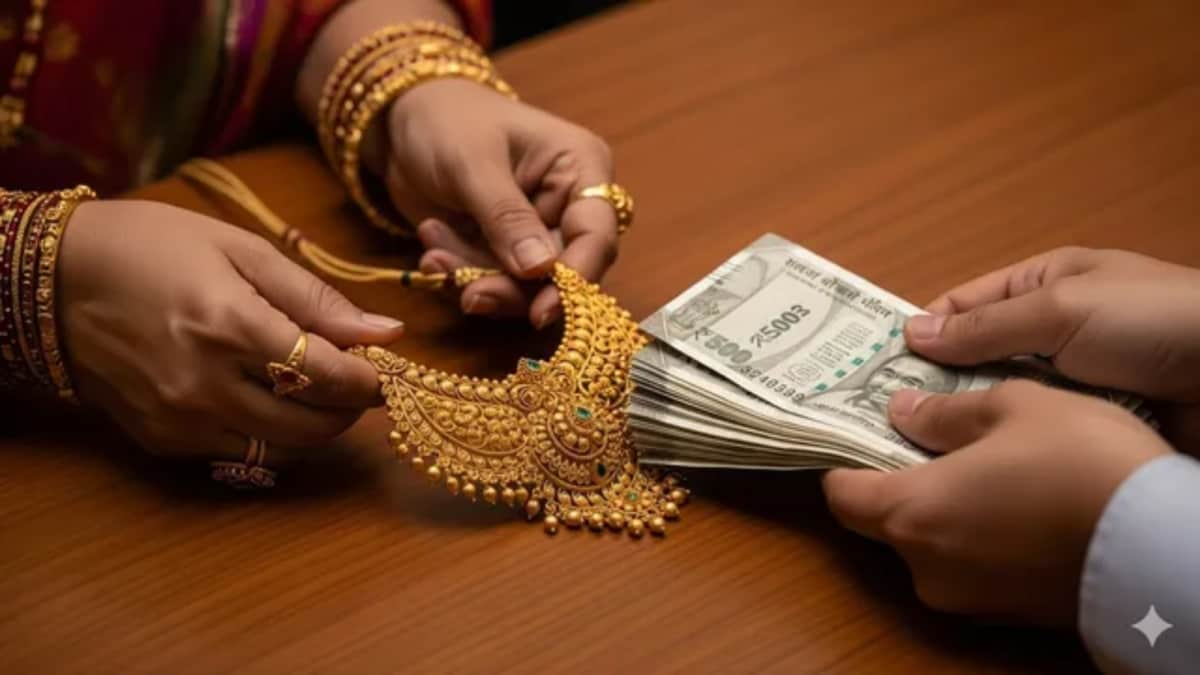Business
Gold rate today: Yellow metal rebounds from previous day’s record dip; global prices at $4,146 – The Times of India

Gold prices edged higher on Wednesday as a weaker dollar and bargain hunting lifted demand following a sharp fall in the previous session. Investors are now watching US inflation data closely for hints on the Federal Reserve’s next move on interest rates.Spot gold rose 0.6% to $4,146.47 per ounce at 0636 GMT, recovering some ground after tumbling more than 5% on Tuesday, according to Reuters.Gold and silver had fallen earlier in the day, extending the previous day’s losses. The yellow metal fell 6.3%, recording its biggest intraday decline in over 12 years. Silver also dipped more than 2%.The drop in these precious metals came as investors rushed to lock in their profits, taking their rapid gains. Concerns are also growing that the rallies have entered the bubble territory, Bloomberg reported.Tim Waterer, chief market analyst at KCM Trade said, “Profit taking moves started to snowball,” adding that the declines reflect “high temptation for traders to take profit at price levels which have never been seen before in the gold market.”The metals were dragged down by a combination of factors including geopolitical factors and the end of India’s season of gold buying.Experts call gold’s recent rally has been remarkable, driven by falling bond yields, steady central bank purchases, and hopes of further monetary easing.Fawad Razaqzada of City Index told Bloomberg, “Markets rarely move in straight lines.” “ While corrections are natural, it is worth pointing out that many investors missed out on the big rally. Soon, they may step in to buy the dip, which should keep the selloff contained.”
Business
Volkswagen capex recalibration: Automaker pares 2030 investment to $186 bn; China, US headwinds grow – The Times of India

Volkswagen Group plans to invest €160 billion ($186 billion) through 2030, a scaled-down outlay that reflects tightening capital allocation as Europe’s largest automaker grapples with mounting pressure in its two biggest markets — China and the United States, Reuters reported.The investment figure, announced by Volkswagen CEO Oliver Blume, is part of the company’s rolling five-year capital expenditure plan, which is updated annually. The latest commitment compares with €165 billion earmarked for 2025–2029 and €180 billion for 2024–2028, with 2024 marking the peak year for spending.Since that peak, the group — which houses brands such as Porsche and Audi — has been squeezed by higher costs and weaker margins, hit by US tariffs on imported vehicles and intensifying competition in China. The strain has been felt most acutely at Porsche, which derives nearly half of its sales from the US and China combined.Porsche recently unveiled a significant rollback of its electric vehicle strategy as profits came under pressure. Speaking to Frankfurter Allgemeine Sonntagszeitung, Blume said the focus of the latest investment plan was firmly “on Germany and Europe,” particularly in products, technology and infrastructure.Blume added that discussions on an extended savings programme at Porsche are expected to continue into 2026. He also said he does not expect Porsche to grow in China, though localising production across the wider Volkswagen group remains an option. A China-specific Porsche model could make sense at some point, he said.On Audi, Blume noted that any decision on building a manufacturing plant in the United States would depend on whether Washington offers substantial financial support.Blume, who will step down as Porsche CEO in January to concentrate fully on running Volkswagen Group, said his recent contract extension as Volkswagen chief executive until 2030 signalled continued backing from the Porsche and Piëch families as well as the German state of Lower Saxony, the company’s largest shareholders.“But it is true, of course, that shareholders have suffered losses since Porsche went public three years ago. I, too, must face up to this criticism,” he said.
Business
Power as ‘currency’: Experts say data centre growth lifts demand; India poised for global leadership – The Times of India

India’s expanding data centre and artificial intelligence ecosystem could position the country as a global leader in power trade, with experts pointing to surplus electricity capacity and rapid reforms in the power distribution sector, according to speakers at a national conference on energy and technology.Speaking at the National Conference on AI and Machine Learning based solutions in the power sector, Jitendra Srivastava, chairman and managing director of REC Limited, said the rapid rise of AI and data centres is creating a new era where electricity itself becomes a strategic asset, according to ANI.“With the exploding growth of artificial intelligence, with the exploding growth of data centres, with the sheer amount of power required to function these places…We are going to see an era when power will be the currency and we are uniquely placed with its huge potential with its already surplus status. We are poised to become world leaders. We are in a position where we can show the world that power is a tradable commodity and we can be global leaders in this,” Srivastava said.The conference brought together solution providers and power distribution companies with the aim of enabling collaboration and innovation. Shashank Mishra, Joint Secretary in the Ministry of Power, said the initiative was designed to create a common platform for developing new solutions.“Today we are bringing together solution providers and distribution companies on a single platform where they can interact and develop new solutions and ideas. We are also presenting several innovative concepts in the form of solutions, and the best among them will be awarded by the Minister of Power,” Mishra told ANI.He added that the government expects the initiative to be “a transformative” step for the sector.Highlighting ongoing reforms, Srivastava said the Ministry of Power has been driving changes under the Revamped Distribution Sector Scheme (RDSS), with smart metering forming a core pillar of the programme. He stressed that the benefits of smart meters can be fully realised only with the use of advanced analytics.“To understand the advantages of smart metering, it is essential to leverage the power of artificial intelligence and machine learning,” he said, adding that such tools can aid anti-theft measures, load forecasting and system rationalisation.According to Srivastava, the conference seeks to demonstrate how AI- and machine learning-based tools can improve consumer services, assist electricity regulators and help discoms function more efficiently.India’s energy sector has strengthened significantly in recent years, balancing rising demand with sustainability goals. Citing International Energy Agency projections, speakers noted that emerging and developing economies will account for about 85 per cent of the growth in global electricity demand over the next three years, with India playing a central role.As of June 2025, India’s total installed power capacity stood at 476 GW, while power shortages have declined sharply from 4.2 per cent in 2013-14 to 0.1 per cent in 2024-25, according to official data.
Business
‘Next big clean-up’: FM Sitharaman flags customs simplification; hints at duty rationalisation in Budget – The Times of India

Ahead of Budget 2026, Finance Minister Nirmala Sitharaman on Saturday said simplifying India’s customs framework will be the government’s next major reform focus, signalling a comprehensive clean-up aimed at making compliance easier and more transparent.Speaking at the HT Leadership Summit, Sitharaman said customs reforms would follow the rationalisation efforts already undertaken in income tax and Goods and Services Tax (GST) to boost consumption by leaving more cash in the hands of consumers, PTI reported.“We need a complete overhaul of customs… we need to have customs simplified for people to feel that it is not cumbersome to comply… need to make it more transparent,” the finance minister said.She said the government intends to bring the same virtues of transparency and ease that guided income-tax reforms to the customs regime, adding that the proposed changes would include further rationalisation of customs duty rates.The finance minister indicated that announcements to this effect may be made in the Union Budget, likely to be presented on February 1.“We have brought down customs duty over the last two years steadily. But in those few items where our rates are considered to be over the optimal level, we have to bring them down as well. Customs is my next big cleaning-up assignment,” she said.In this year’s Budget, the government proposed eliminating seven additional customs tariff rates on industrial goods, following the removal of seven tariff slabs in 2023-24. This reduced the total number of customs tariff slabs to eight, including a zero rate.On the rupee’s sharp depreciation, Sitharaman said the currency would find its natural level. The rupee has weakened about 5 per cent against the US dollar during calendar year 2025.The currency breached the 90-per-dollar mark for the first time earlier this week, settling at a provisional all-time low of 90.21 amid sustained foreign fund outflows and elevated crude oil prices, PTI noted.On economic growth, Sitharaman expressed confidence that India’s GDP expansion would remain at 7 per cent or above in the current financial year.The Indian economy grew at a six-quarter high of 8.2 per cent in the July-September quarter, aided by stronger factory output and robust services-sector performance, offsetting a slowdown in farm output. Growth stood at 7.8 per cent in the preceding quarter and 5.6 per cent a year earlier.For the first half of the financial year ended September, India clocked GDP growth of 8 per cent.
-

 Sports6 days ago
Sports6 days agoIndia Triumphs Over South Africa in First ODI Thanks to Kohli’s Heroics – SUCH TV
-

 Tech6 days ago
Tech6 days agoGet Your Steps In From Your Home Office With This Walking Pad—On Sale This Week
-

 Fashion5 days ago
Fashion5 days agoResults are in: US Black Friday store visits down, e-visits up, apparel shines
-

 Entertainment5 days ago
Entertainment5 days agoSadie Sink talks about the future of Max in ‘Stranger Things’
-

 Politics5 days ago
Politics5 days agoElon Musk reveals partner’s half-Indian roots, son’s middle name ‘Sekhar’
-

 Tech5 days ago
Tech5 days agoPrague’s City Center Sparkles, Buzzes, and Burns at the Signal Festival
-

 Sports6 days ago
Sports6 days agoBroncos secure thrilling OT victory over Commanders behind clutch performances
-

 Entertainment5 days ago
Entertainment5 days agoNatalia Dyer explains Nancy Wheeler’s key blunder in Stranger Things 5











